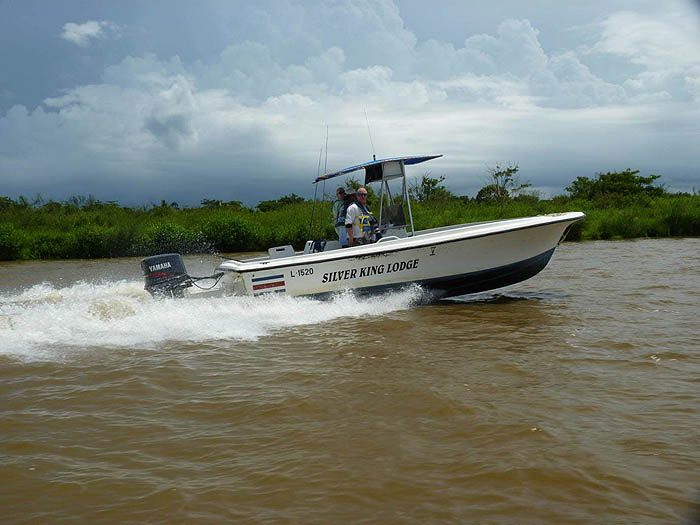 '
'Information Page.
Costa Rica tarpon.
My pal Steve Pitts and I really enjoy our annual holiday fishing trips. We are currently thinking of trying to publish a book on holiday fishing in both fresh and saltwater (not sure what the market will be!). Anyway, Steve has just returned from a trip to Costa Rica and I thought you might like to hear a bit about it. As usual there are some of Steve's excellent pictures :-
Hi Mike
I promised to write up a few words on my recent trip to the Caribbean coast of Cost Rica.
A group of seven of us fished out of Silver King Lodge, which is situated in the wilderness reserve of Barra del Colorado, up in the extreme North of Costa Rica; in fact we were just a few miles from the border with Nicaragua. The trip was organised by Austen Goldsmith of uksaltwaterflies.
We booked ‘Continental’ flights to San José via New York and then an early morning light aircraft transfer up to the lodge, including some spectacular views of the smouldering volcano Mount Irazú. I’m getting a taste for this light aircraft malarkey – it’s the only way to travel!
We had time for a quick bite to eat for breakfast and then we were off down the river to the open sea, where it was rumoured that big tarpon hang out and I must say that the rumours are true - some very big tarpon have taken up residence around the river mouth and can be caught on bait, lures and fly gear all year round. I don’t know why these big fish stay there - must be an abundance of food I guess, or perhaps these very big fish have lost the urge to spawn/migrate like the ‘smaller’ ones (under 120lb) do.
As it happens, the largest fish caught during our stay was around the 170 -180lb mark, with several fish also 'leadered' at 150lb or thereabouts. The average size was 120ish.
The lodge is situated only a mile up-river from the estuary of the Rio Colorado, so the trip down to the open ocean takes just five minutes in the 21ft centre-console boats that we had the use of for the duration of our 6 day stay. We split into pairs, two to a boat and all except me were dyed in the wool fly-rodders. You’ll remember my shameful lack of ability with the fly rod if you cast your mind back to our trip to Belize, (He's actually very competent - well, a lot better than me anyway! ML) so I was armed with a couple of spinning rods including a new tarpon trek rod from FOX, which is more like a boat rod, but I able to cast heavy poppers of around 2oz with it and it had plenty of grunt in the butt section too.
In order to leave the estuary we (or to be more precise, our guide Chris,) had to navigate around a series of sand bars which were chucking up several lines of very lively surf (think Broad Bench during a good blow!). It was a bit of a white-knuckle ride to say the least, with us racing along, parallel to the waves, and then turning hard over to port, sharply through 90 degrees, through any gap in the surf that Chris had spotted. Then, racing back along in front of the next wave, but in the opposite direction and again, hard over on the wheel to starboard to breach the oncoming wall of water.
This wasn’t quite the welcome I’d envisaged and it was a little disconcerting to think that we’d have to brave this onslaught every day, but as it happened these were unusual conditions as the incoming spring tides and rain-laden river were meeting head-on and thankfully the maelstrom abated over the course of the next 24 hours as the river’s level dropped.
My fishing companion and I were sat in the back of the boat, just a few feet from the 150hp Yamaha outboard. Its running note varied between a gentle burble at idle revs, as Chris judged the timing of his assault on the incoming waves, then a growling roar as he gunned the throttle, followed by a tortured scream when the engine’s prop momentarily peaked at maximum revs as we crested the wave and then we were airborne for a split second, followed by a spine-jarring slam as we landed back on the Caribbean. ‘This is fun’ I said through clenched teeth. My buttocks were tightly clenched too, but perhaps that’s too much information to be giving you at this stage, so forget I mentioned that.
My boat companion was a fellow veteran of two Seychelles trips, Murat Kece. Murat had brought with him a 12 weight fly rod, which I have to admit, I had reservations about. The other fly rodders in our group had all brought 14 and 15 weight rods with them. Virtually impossible to cast a fly with, but about the right rating for hauling on big tarpon. We fished on the drift. It didn’t take long before Murat was testing the #12 Sage out on one of the biggest tarpon I’d ever seen- Christ it was big! After much leaping (the tarpon) and groaning (Murat and the Sage) the fish was holding position under the boat. Now it was case of gritting his teeth and pushing the Sage to near destruction to get the tarpon within gaffing distance. I watched, with one eye closed and my face contorted as if someone was scraping their finger nails down a blackboard as Murat gave that tarpon all he and the rod could give.
Miraculously, the carbon fibre, resin and ring whippings all held out and Chris slipped the gaff into the gaping chasm of the tarpon’s mouth and deftly yanked the big hook home. Most of the tarpon here are gaffed – not something that I was prepared to sanction for anything that I caught - but our first fish was chin gaffed and (of course) it went mental (I just knew it would) and it nearly ripped the gaff from Chris and Murat’s grip. To be honest chin gaffing is just about the only practical way of getting a fish and angler in a photo together, as they are just too big and dangerous to get into the boat, so they are suspended on the end of the gaff while the camera clicks and the angler poses.
All that weight on the fishes’ jaw can’t do them any good at all, so we agreed that this would be that last gaffing on our boat for the duration of the trip. Subsequent tarpon would be leadered alongside the boat and the hook popped out with a long disgorger. As long as the leader was grasped by Chris then the fish was counted as having been landed then honour was satisfied and the fish released without the trauma.
Out of every 10 takes we successfully 'landed' around 3.5 tarpon. The rest threw the hooks during their acrobatics or a few rubbed through the 150lb mono leader. On my FOX tarpon rod I could get most fish hooked, played out and released within 20 minutes but some of the big fish that the fly guys were catching were taking considerably longer than an hour to land.
We had a new guest arrive after our first couple of days and what a character he was.
George J. Malina is a retired civil engineer from Chicago and this was his 32nd visit to Silver King Lodge - so you could say that he knew the score about the local tarpon.
His favoured method was jigging for them and he had perfected both the lures and tackle set-up, which he felt gave him the ability to catch fish at all depths (the water ranged from 12ft to 50ft deep) and boat them quickly and efficiently so that they could be measured to get their vital statistics - length and girth.
Now I’m not saying that it was boring catching ton-up tarpon, but I hadn’t come all this way to ignore the other species that I felt must be available inside the river system, so I opted for three afternoon’s fishing in the Rio Colorado and its many tributaries.
It was a fascinating journey into lush, forested backwaters and nowhere was it possible to gain access to the river without a boat, unless you happened to be a howler monkey, a caiman or a macaw – of which we saw many. I was hoping for guapote, snook and juvenile tarpon, but only managed a half decent snook, late one afternoon, by flicking surface lures and shallow divers in under the overhanging growth.
The week progressed and the tally of tarpon steadily averaged 4 or 5 fish boated per boat per day. That doesn’t sound too hectic, but consider the numbers of takes, hook-ups, played and lost fish and the hours of torturous effort needed to subdue those fish it was pretty frantic.
Two Finnish anglers, Mikka and Ville, landed a couple of absolute monsters on fly gear. If any fish came close to the magic 200lb mark, these the main contenders.
An interesting feature, that dictated the fishing hotspots, was the very obvious demarcation between the freshwater of the Colorado and the sea water of the Caribbean. For a long way out to sea, the water was stained murky brown and there was a distinctly visible borderline where the fresh and salt waters met. It was almost like oil and water not wanting to mix. The boundary between the two bodies of water was so complete that the waves of the sea were abruptly dampened when they rolled up against the less dense freshwater.
Most of the big tarpon were caught in the murky (fresh) water, but we did see large pods of tarpon rolling on the surface out in the clear water of the ocean. They seldom appeared interested in taking even a well-behaved live bait dropped on their noses though. You could drift along the demarcation line and get bites in the turbid freshwater, but almost nothing in the clear saltwater. I found this somewhat confusing and can only surmise that the tarpon were feeding more aggressively in the murk by employing a ‘grab it or lose it’ strategy. The takes were certainly ferocious, but how they could find a fly (even a six-inch orange and black monstrosity) wafting in the tide or an inert dead bait trailed behind the boat in zero visibility was a complete mystery to me.
Well I really enjoyed that - made me wish that I'd gone with him. Now for the pictures.
Here they go.
 '
'Whoops!!!!
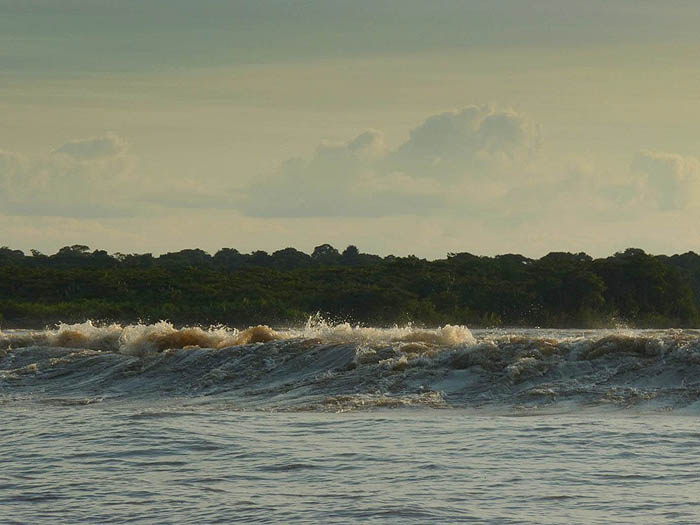 '
'Contrast!
 '
'He's in!
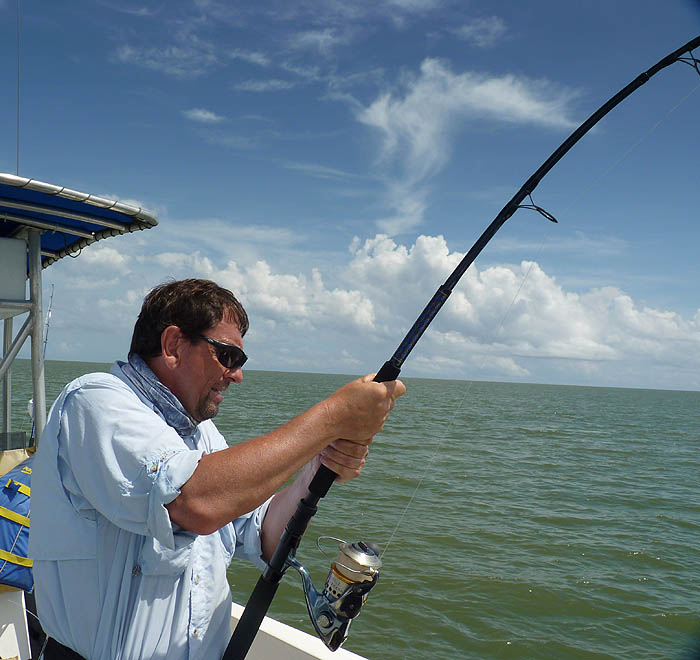 '
'Aaaaaahhhhh!!!!.
 '
''Landed.'.
 '
'Crevalle.
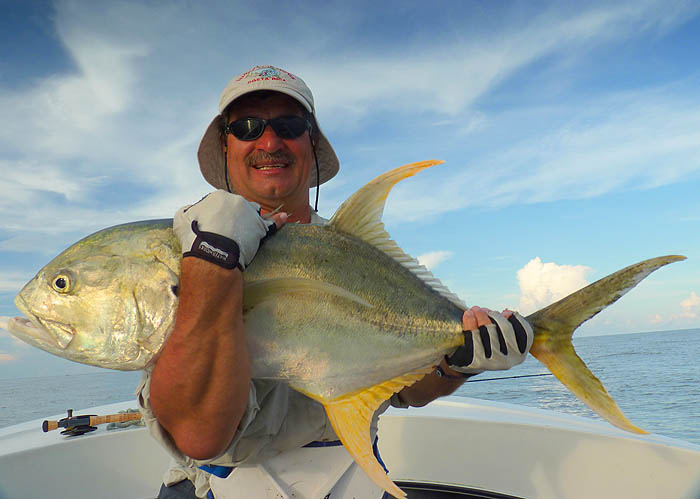 '
'Tripletail.
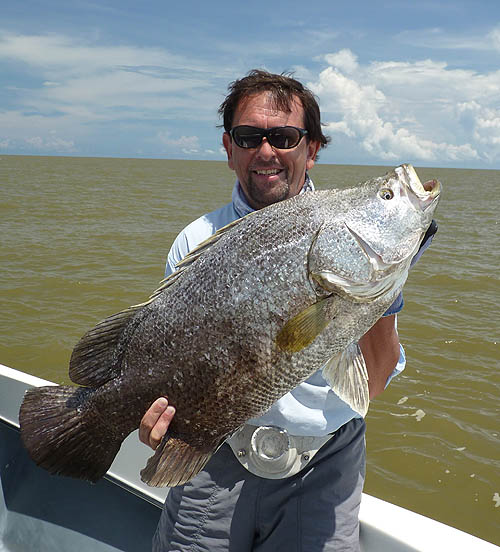 '
'Snook.
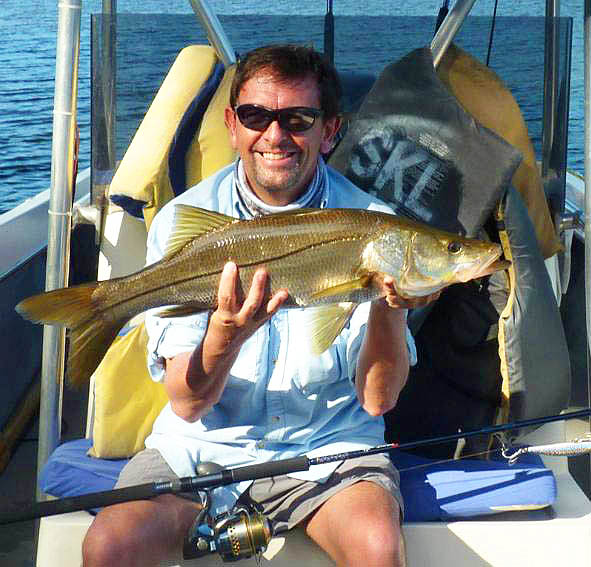 '
'Catfish.
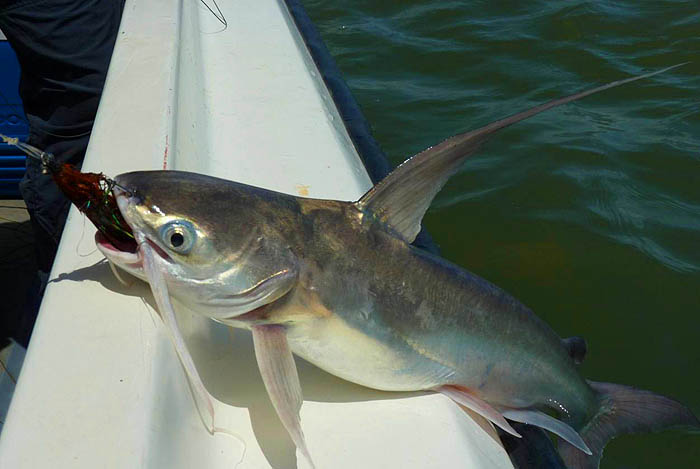 '
'Fantastic.
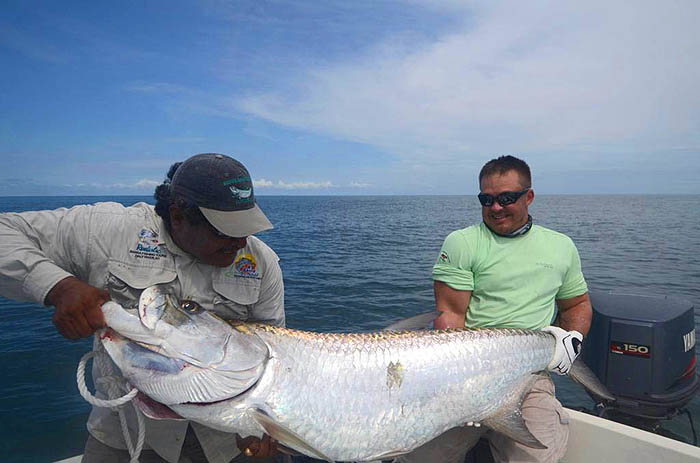 '
'If you have any comments or questions about fish, methods, tactics or 'what have you.'get in touch with me by sending an E-MAIL to - docladle@hotmail.com